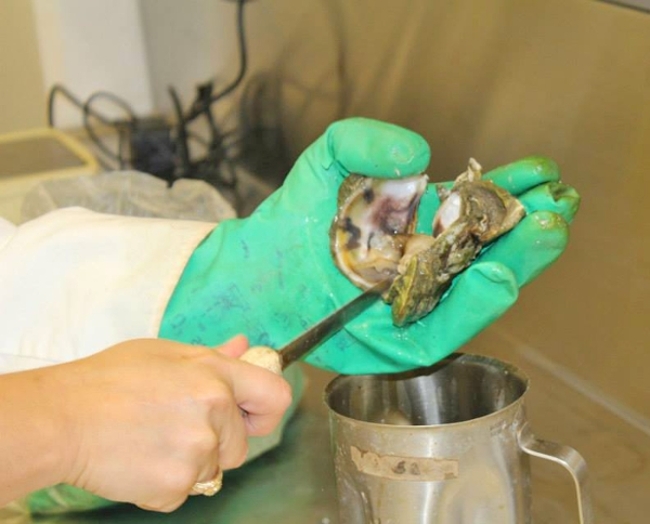Texas Primed to be Pearl in New Oyster Farming Industry Say Texas A&M-Galveston Experts
July 1, 2020
Tweet
By Andréa Bolt, Communications Specialist, Division of Marketing & Communications
Whether you love them or hate them, you can’t deny that oysters are a staple in the Gulf Coast diet. That’s why it’s big news that Texas will finally be allowed to take part in and financially benefit from oyster farming.
Yes, farming.
Only this kind of farming doesn’t involve tractors, seeds or soil, says Texas A&M University at Galveston Seafood Safety Lab Manager Mona Hochman ‘94.
“Think floating cages, longlines and a visibly segmented area within a bay,” she advised.
As manager of Texas’ only oyster-testing lab, Hochman is keenly aware of the myriad issues associated with eating oysters and how proper growth and harvesting techniques can translate to the new oyster farming industry.
The farming process largely utilizes floating cages, from which the oysters can be harvested once they reach the appropriate size. Nationally, the farmed or cultured oyster industry generates in the hundreds of millions of dollars. In Texas, the practice could become similarly profitable.
Throughout the other gulf states; Louisiana, Mississippi, Alabama, and Florida, this practice is already fairly commonplace. But for Texas, the last state in the gulf to legalize off-bottom oyster mariculture, the process is still being put in place and regulations are still being cemented.
Just last month, the Texas Parks and Wildlife Commission (TPWD) approved a set of rules for oyster mariculture, laying the groundwork for the state’s newest industry. Thus, Texans are now able to apply for permits allowing for the lease of public water for farming purposes. That said, the locations of these operations will need to be approved by TPWD and other state agencies, and farmers will be subject to annual fees, mandatory transport documents, reporting requirements and other regulations set forth by both the state and federal governments concerning safety precautions.
Hochman says Texas could’ve been late to the game for a number of reasons, including supply and demand, hurricanes, and the large investment necessary to break into the industry.
“Texas bays historically were mass producers of wild oysters, meaning we didn’t need oyster farms,” she explains. “In 1999, roughly 6.4 million pounds of oysters were harvested from Texas bays, with 95% of that coming out of Galveston Bay. Following Hurricanes Ike and Harvey, Galveston Bay has suffered great loss in natural oyster beds due to siltation and influxes of fresh water.”
The National Oceanic & Atmospheric Administration (NOAA) echoes Hochman’s sentiments. According to a recent report, global wild oyster harvests have declined by 43% since 2000, likely prompting the need for alternate avenues of production.

Hochman says that because the oysters will likely be suspended in floating cages, they won’t be subject to siltation, which is when they become covered by sediment like mud, sand or other natural and unnatural debris. Siltation can come from runoff as a result of storms or hurricanes, or even from vessel traffic in nearby waters.
“These culturing systems can be placed in areas with optimal water conditions (flow rate, nutrients, etc.) and moved if necessary,” she explained. “Cultured oysters grow individually, as opposed to being in a conglomerate when wild (with many oysters attached to each other). These individual oysters are able to grow with a deeper cup and more uniform shell, which is preferred by the restaurant industry and oyster connoisseurs. Additionally, oysters cultured in the water column are less likely to house or become prey for benthic worms and crabs.
Hochman also says this type of farming or culturing system allows for the cages holding the oysters to be lifted out of the water intermittently to reduce biofouling, when microorganisms like algae or animals like barnacles can grow on the oysters’ shells.
As for the other marine life like corals, fish or even birds that could be impacted by these watery farm areas, the state also has that covered.
“TPWD is also setting a great number of regulations regarding where farming can occur based on the natural substrate, oyster reefs, seagrass beds, etc. They will be regulating all oyster farming and, I believe, be at least partially responsible for granting permits to farm,” she said.
Further making farming attractive is decreased growth time.
While wild oysters typically take 18 months to two years to reach harvestable size, Hochman says the cultivated oysters will likely be harvestable within a year’s time, though after certain strains are established.
“Because cultivated oysters will be triploid (sterile) they can devote all their energy to growing instead of reproduction, allowing them to grow faster. Also, cultured oysters will be legally harvestable at 2.5-inches, while the limit for wild oysters is 3-inches,” she says.
Lastly, Hochman says, is the issue of food safety, about which she’s not too worried.
“Most of the people who will likely begin with these systems are already oyster harvesters themselves who are aware of the issues with bacteria and other diseases. In any event, the Seafood Safety Lab is available to work with oyster farmers to ensure they are producing a safe product for the consuming public.”
###
Media contact:Communications Specialist
a_bolt@tamug.edu
More:
Read more about Business, Law & Society
Read more about Health & Environment
Read more about Science & Technology
Read more about Marine Biology
Read more about Marine Sciences